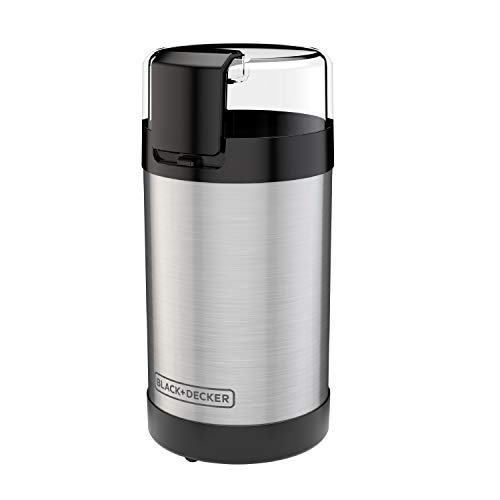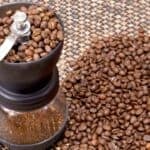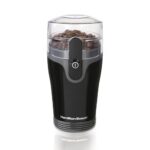A coffee grinder is a useful tool for grinding wheat. However, it is important to know that not all coffee grinders will work for this purpose. Some coffee grinders are designed specifically for grinding coffee beans and may not work well for grinding wheat.
Additionally, some coffee grinders can overheat when used to grind wheat, which can damage the wheat or make it difficult to grind evenly. If you want to use a coffee grinder to grind wheat, it is important to choose the right type of grinder and use it properly.
- Place the wheat in the coffee grinder
- Turn on the coffee grinder
- Grind the wheat for 1-2 minutes, or until it is a fine powder
- Enjoy your freshly ground wheat!
You May Like
- EASY CLEANUP — DISHWASHER SAFE GRINDING BOWL: The grinding bowl on…
- GRIND ENOUGH TO BREW UP TO 12 CUPS OF COFFEE: If you love the…
- SIMPLE & INTUITIVE: The coffee grinder is so easy to use that you’ll…
- DURABLE STAINLESS STEEL BLADES: With the durable stainless steel…
- Electric coffee bean grinder appliance for home use
- Can grind 30 grams/1 ounce of beans for drip coffee brewing in 10…
- Grind coffee beans, herbs, spices, grains, nuts, and more
- Clear safety lid allows you to easily see the results in progress
- ENJOY OPTIMUM FLAVOR: Burr grinding provides a uniform grind to your…
- REMOVABLE FEATURES: Our 8 oz. bean hopper is fully removable as well…
- GRIND CHAMBER: Our removable grind chamber holds enough ground coffee…
- ONE-TOUCH GRIND: The one-touch power bar is separate from the unit and…
- ✅【A Secret To Grind Bean Effortlessly】Grinder comes with a pure…
- ✅【Coarse Or Fine By Your Finger】Pour in up to 60g beans, put the…
- ✅【Rich Aroma & Fresh Flavor】Pure copper motor, stainless steel…
- ✅【Save Your Precious Counter Space】Wancle coffee grinder…
- STAINLESS STEEL BLADES AND BOWL – The sharp blades and durable…
- GRIND YOUR FAVORITES! – Stainless steel blades quickly grind your…
- ONE TOUCH PUSH-BUTTON CONTROL – Intuitive push-button control lets you…
- LID-LOCKING SAFETY FEATURE – No spills, no accidents. The integrated…
Can You Grind Wheat in a Coffee Grinder
Can We Grind Wheat in Coffee Grinder?
Yes, you can grind wheat in a coffee grinder, but it is not recommended because the coffee grinder will not be able to produce a fine enough grind for flour and will heat up the wheat kernels, potentially damaging their nutrients.
Can You Grind Other Things in a Coffee Grinder?
Coffee grinders are designed to grind coffee beans. However, there are some people who use them to grind other things, such as spices or nuts. While this is possible, it is not recommended because it can damage the grinder and affect the taste of the coffee.
Additionally, grinding other things in a coffee grinder can create a dust that can be harmful if inhaled.
How Do You Grind Wheat at Home?
There are several ways to grind wheat at home, depending on what kind of equipment you have. The most common way is to use a grain mill, which can be either electric or manual. If you don’t have a grain mill, you can also use a coffee grinder, food processor, or blender.
Just make sure that whatever appliance you use is dedicated to grinding wheat and not used for anything else, as this will contaminate the wheat and make it unsuitable for consumption.
To grind wheat using a grain mill, start by pouring your wheat berries into the hopper on top of the mill. Depending on the size of your mill, you may need to do this in batches.
Then, turn on the machine and wait for the wheat berries to be ground into flour. Some mills have settings that allow you to control how fine or coarse the flour is; if yours doesn’t have this feature, simply let it run until all of the berries have been ground. Once finished, turn off the machine and remove any excess flour from around the blades before opening up the hopper to access your fresh-ground flour.
How Do You Grind Wheat Without a Grinder?
If you don’t have a grinder, you can use a food processor, blender, or even a coffee grinder to grind wheat. Just pulse the wheat in short bursts until it reaches the desired consistency. You can also use a mortar and pestle to grind wheat into a coarse flour.
If all else fails, you can always whole wheat berries in a bag and use them as is.
Can You Grind Corn in a Coffee Grinder
Are you in a pinch and need to grind some corn, but don’t have a dedicated grinder for it? No problem! You can easily use your coffee grinder to do the job.
Just make sure to give it a good cleaning afterward so that your coffee doesn’t end up tasting like corn. Here’s how to do it:
1. Pour your kernels into the grinder. Start with a small amount – maybe 1/4 cup or so – and go from there. If you’re using a blade grinder, give it a few pulses until the kernels are broken up and have started to turn into powder. If you’re using a burr grinder, adjust the setting until you get the consistency that you want.
2. Keep grinding until all of the kernels have been turned into powder. Again, start with small amounts and pulse if necessary so that you don’t overdo it, and end up with cornmeal instead of powder.
3. When finished, pour out the contents of the grinder into a bowl or container. Give your grinder a good shake or tap so that all of the powder falls out – you don’t want any leftover bits stuck in there! And that’s it – you’ve now successfully ground your own corn flour or meal using nothing but your coffee grinder. Enjoy!
Grain Mill Vs Coffee Grinder
When it comes to choosing between a grain mill and a coffee grinder, there are a few things you need to take into consideration. The most important factor is what you will be using the machine for. If you plan on grinding wheat berries or other grains into flour, then a grain mill is an essential tool.
Coffee grinders, on the other hand, are designed specifically for grinding coffee beans.
Another thing to consider is the size of the particles you want to produce. Grain mills can grind your grains into a very fine powder if that’s what you need, while coffee grinders typically produce a coarser grind.
If you’re not sure which grind size is right for your recipe, it’s best to experiment until you find the perfect setting.
Finally, think about how much money you want to spend on a new machine. Grain mills can be quite expensive, while coffee grinders are usually more affordable.
Of course, this isn’t always the case – there are high-end models of both types of machines – but it’s something to keep in mind as you shop around.
So, which should you choose: a grain mill or a coffee grinder? It all depends on your needs and preferences.
If you’re looking for versatility and the ability to produce very fine powders, go with a grain mill. If cost is more important than particle size, then opt for a coffee grinder instead. And if you just can’t decide, why not get both?
That way you’ll be prepared for anything!
How to Grind Wheat into Flour
If you’re interested in grinding wheat into flour, there are a few different ways that you can do it. Depending on the type of wheat and the desired coarseness of the flour, you may want to use a different method or machine. Here is a brief overview of how to grind wheat into flour using three different methods:
1. Grinding wheat in a food processor: If you have a food processor at home, this is probably the easiest way to grind wheat into flour. Simply add the wheat kernels (also called berries) into the food processor bowl and pulse until they’re ground to your desired level of coarseness. Be sure not to overdo it or you’ll end up with powder instead of flour!
2. Grinding wheat in a coffee grinder: Another option for grinding wheat berries is to use a coffee grinder. This works well if you only need a small amount of flour and don’t mind if it’s not perfectly uniform in texture. Just add some berries to the grinder and pulse until they reach your desired consistency.
Again, be careful not to overdo it!
3. Grinding wheat in a blender: If you don’t have either a food processor or coffee grinder, you can try using a blender instead. This method will take longer than either of the other two since you’ll need to stop and scrape down the sides frequently, but it will eventually get the job done.
Just add some berries to your blender and pulse until they reach your desired consistency – easy as that!
How to Hand Grind Wheat into Flour
There are many benefits to grinding your own wheat into flour. Hand grinding is an easy way to do this, and it allows you to control the grind size so that you can get the perfect flour for your recipes. Here’s how to hand grind wheat into flour:
1. Start with whole wheat berries. You can purchase these at a health food store or online.
2. Place the wheat berries in a bowl and add enough water to cover them. Let them soak for at least eight hours, or overnight.
3. Drain the soaked wheat berries and place them on a clean towel to dry. 4. Place the dried wheat berries in a coffee grinder or food processor and pulse until they’re finely ground into flour.
Sift the flour through a mesh strainer if desired (this will remove any larger pieces of bran). 5. Store the flour in an airtight container in the fridge until ready to use (it will keep fresh for up to six months).
Can You Grind Farro into Flour
If you’ve ever wondered if you can grind farro into flour, the answer is yes! This nutritious grain can easily be turned into a fine powder that can be used in all sorts of recipes.
Farro is a versatile grain that can be used in both sweet and savory dishes.
It has a nutty flavor and chewy texture that makes it perfect for using in baking or as a substitute for rice or pasta. And since it’s packed with fiber and protein, grinding it into flour is a great way to boost the nutrition of your favorite recipes.
To grind farro into flour, simply place the grain into a food processor or high-powered blender and pulse until it reaches the desired consistency.
Then, use it just as you would any other type of flour – in pancakes, muffins, cookies, or even bread! Just remember that since farro contains gluten, it’s not suitable for those with celiac disease or gluten sensitivities.
Burr Grinder Wheat
If you’re looking for a wheat grinder that can handle the tough grinding job of wheat, you want a burr grinder. Burr grinders use abrasive surfaces to grind food, and they’re up to the task of whole wheat berries. But what is a burr grinder, and how do you choose the right one for your needs?
A burr grinder is a type of grinder that uses two revolving abrasive surfaces (called burrs), rather than blades, to crush and grind food. The advantage of using burrs instead of blades is that they create a more uniform grind, which results in better flavor extraction from your coffee beans or wheat berries. Burr grinders come in both manual and electric models; if you’re considering an electric model, look for one with adjustable speed settings so that you can find the perfect grind for your particular grain.
When choosing a manual wheat grinder, it’s important to consider how much wheat you’ll be grinding at once. If you only need to process small amounts of wheat at a time, then a small hand-cranked mill should suffice. However, if you plan on doing larger batches or grinding on a regular basis, then an electric model will be worth the investment.
Whichever style of burr grinder you choose, make sure that theburrs are made from high-quality materials such as ceramic or stainless steel; these will last longer and produce a better quality grind than cheaper options like plastic or aluminum.
Can You Make Flour With a Mortar And Pestle
One of the most common questions we get asked is whether or not you can make flour with a mortar and pestle. The answer is yes! With a little elbow grease, you can turn whole grains into fresh, nutritious flour.
Here’s how:
Start with clean, dry grains. We recommend using hard red wheat berries, but you can also use rye, barley, oats, rice, quinoa, or corn.
If using corn, start with dried kernels rather than sweetcorn on the cob.
Place the desired amount of grain in your mortar and grind away! Use a circular motions and be sure to apply even pressure.
It will take some time to get a fine powder – be patient and keep grinding.
Once you have a fine powder, sift it through a mesh strainer to remove any larger pieces that didn’t quite grind down completely. And that’s it – you’ve now made your own freshly milled flour!
Homemade Flour Mill Plans
A flour mill is a great addition to any homestead or prepper’s stockpile. Not only will it allow you to grind your own wheat, corn, rice, or other grains, but you can also use it to mill non-food items like spices and coffee beans. Best of all, if you have the right plans, a homemade flour mill is relatively easy and inexpensive to build.
There are a few different types of flour mills that you can build at home. The most common is the hand-cranked model that sits on your countertop. These are typically small and lightweight, making them easy to move around and store.
Some hand-cranked models even come with attachments that allow you to power them with a bicycle or treadmill.
If you’re looking for a more heavy-duty option, there are also plans available for building electric flour mills. These are larger and more expensive to build than their hand-cranked counterparts, but they’re also much faster and easier to use.
If you have regular need for large quantities of fresh flour, an electric mill may be worth the investment.
No matter which type of mill you choose to build, the process is pretty much the same: grains are poured into the top of the machine and crushed between two grinding stones or steel burrs until they’re reduced to a fine powder. The finer the setting on your mill, the finer the flour will be – though it will also take longer to produce.
Coarser settings are better for things like cornmeal or cracked wheat cereals.
Conclusion
If you’ve ever wondered whether you can grind wheat in a coffee grinder, the answer is yes! You can use your coffee grinder to grind wheat into flour. This is a great way to create your own fresh, whole wheat flour at home.
grinding wheat in a coffee grinder is simple: just pour some wheat berries into the grinder and let it do its work! In no time, you’ll have fresh-ground flour that you can use for all sorts of recipes.

Hi, this is Cynthia A. Rose. Welcome to my Grinder related blog. Usually, I am busy with my kitchen and cooking all day. My main desire is to create a new recipe every day. But I have to use new tools every day to create new recipes. In this blog, I will share you how to use kitchen tools properly. I will not just share cooking related equipment, I will try to review all kinds of grinders like angle grinder among you. I hope my 12 years of experience will come in handy. Thanks!









